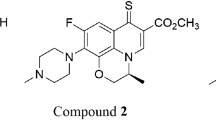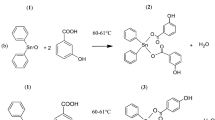Abstract
Copper complexes have been widely studied for the anti-tumour application as cancer cells are reported to take up greater amounts of copper than normal cells. Preliminary study revealed that the newly synthesised copper complex [Cu(SBCM)2] displayed marked anti-proliferative towards triple-negative MDA-MB-231 breast cancer cells. Therefore, Cu(SBCM)2 has great potential to be developed as an agent for the management of breast cancer. The present study was carried out to investigate the mode of cell death induced by Cu(SBCM)2 towards MDA-MB-231 breast cancer cells. The inhibitory and morphological changes of MDA-MB-231 cells treated with Cu(SBCM)2 was determined by using MTT assay and inverted light microscope, respectively. The safety profile of Cu(SBCM)2 was also evaluated towards human dermal fibroblast (HDF) normal cells. Confirmation of apoptosis and cell cycle arrest were determined by flow cytometry analysis. The expression of p53, Bax, Bcl-2 and MMP2 protein were detected with western blot analysis. Cu(SBCM)2 significantly inhibited the growth of MDA-MB-231 cells in a dose-dependent manner with GI50 18.7 ± 3.06 µM. Indeed, Cu(SBCM)2 was less toxic towards HDF normal cells with GI50 31.8 ± 4.0 µM. Morphological study revealed that Cu(SBCM)2-treated MDA-MB-231 cells experienced cellular shrinkage, membrane blebbing, chromatin condensation and formation of apoptotic bodies, suggesting that Cu(SBCM)2 induced apoptosis in the cells, which was confirmed by Annexin-V/PI flow cytometry analysis. It was also found that Cu(SBCM)2 induced G2/M phase cell cycle arrest towards MDA-MB-231 cells. The induction of apoptosis and cell cycle arrest in the present study is possibly due to the down-regulation of the mutant p53 and MMP2 protein. In conclusion, Cu(SBCM)2 can be developed as a targeted therapy for the treatment of triple-negative breast cancer.








Similar content being viewed by others
References
Abdullah NA, Wan Mahiyuddin WR, Muhammad NA, Ali ZM, Ibrahim L, Ibrahim Tamim NS, Mustafa AN, Kamaluddin MA (2013) Survival rate of breast cancer patients in Malaysia: a population-based study. Asian Pac J Cancer Prev 14(8):4591–4594. https://doi.org/10.7314/APJCP.2013.14.8.4591
Bagihalli GB, Avaji PG, Patil SA, Badami PS (2008) Synthesis, spectral characterization, in vitro antibacterial, antifungal and cytotoxic activities of Co(II), Ni(II) and Cu(II) complexes with 1,2,4-triazole Schiff bases. Eur J Med Chem 43:2639–2649. https://doi.org/10.1016/j.ejmech.2008.02.013
Barve V, Ahmed F, Adsule S, Banerjee S, Kulkarni S, Katiyar P, Anson CE, Powell AK, Padhye S, Sarkar FH (2006) Synthesis, molecular characterization, and biological activity of novel synthetic derivatives of chromen-4-one in human cancer cells. J Med Chem 49:3800–3808. https://doi.org/10.1021/jm051068y
Cardinale D, Colombo A, Torrisi R, Sandri MT, Civelli M, Salvatici M, Lamantia G, Colombo N, Cortinovis S, Dessanai MA, Nolè F, Veglia F, Cipolla CM (2010) Trastuzumab-induced cardiotoxicity: clinical and prognostic implications of troponin I evaluation. J Clin Oncol 28:3910–3916. https://doi.org/10.1200/JCO.2009.27.3615
Creaven BS, Devereux M, Karcz D, Kellett A, McCann M, Noble A, Walsh M (2009) Copper(II) complexes of coumarin-derived Schiff bases and their anti-Candida activity. J Inorg Biochem 103:1196–1203. https://doi.org/10.1016/j.jinorgbio.2009.05.017
Daniele A, Zito AF, Giannelli G, Divella R, Asselti M, Mazzocca A, Paradiso A, Quaranta M (2010) Expression of metalloproteinases mmp2 and mmp-9 in sentinel lymph node and serum of patients with metastatic and non-metastatic breast cancer. Anticancer Res 30:3521–3527
Datta P, Mukhopadhyay AP, Manna P, Tiekink ER, Sil PC, Sinha C (2011) Structure, photophysics, electrochemistry, DFT calculation, and in vitro antioxidant activity of coumarin Schiff base complexes of Group 6 metal carbonyls. J Inorg Biochem 105:577–588. https://doi.org/10.1016/j.jinorgbio.2010.04.013
Foo JB, Saiful Yazan L, Tor YS, Wibowo A, Ismail N, Armania N, Cheah YK, Abdullah R (2016) Dillenia suffruticosa dichloromethane root extract induced apoptosis towards MDA-MB-231 triple-negative breast cancer cells. J Ethnopharmacol 187:195–204. https://doi.org/10.1016/j.jep.2016.04.048
GLOBOCAN (2012) Breast cancer: estimated incidence, mortality and prevalence world wide in 2012. http://globocan.iarc.fr/Pages/fact_sheets_cancer.aspx. Accessed 10 March 2018
Ichikawa Y, Ghanefar M, Bayeva M, Wu R, Khechaduri A, Naga Prasad SV, Mutharasan RK, Naik TJ, Ardehali H (2014) Cardiotoxicity of doxorubicin is mediated through mitochondrial iron accumulation. J Clin Invest 124:617–630. https://doi.org/10.1172/JCI72931
Jin S, Levine AJ (2001) The p53 functional circuit. J Cell Sci 114:4139–4140
Kaur M, Kohli S, Sandhu S, Bansal Y, Bansal G (2015) Coumarin: a promising scaffold for anticancer agents. Anticancer Agents Med Chem 15(8):1032–1048. https://doi.org/10.2174/1871520615666150101125503
Khan KM, Ambreen N, Hussain S, Perveen S, Iqbal Choudhary M (2009) Schiff bases of 3-formylchromone as thymidine phosphorylase inhibitors. Bioorg and Med Chem 17:2983–2988. https://doi.org/10.1016/j.bmc.2009.03.020
Kulkarni A, Patil SA, Badami PS (2009) Synthesis, characterization, DNA cleavage and in vitro antimicrobial studies of La(III), Th(IV) and VO(IV) complexes with Schiff bases of coumarin derivatives. Eur J Med Chem 44:2904–2912. https://doi.org/10.1016/j.ejmech.2008.12.012
Low M, Paulus G, Dorlet P, Guillot R, Rosli R, Delsuc N, Crouse K, Policar C (2015) Synthesis, characterization and biological activity of Cu(II), Zn(II) and Re(I) complexes derived from S-benzyldithiocarbazate and 3-acetylcoumarin. Biometals 28(3):553–566. https://doi.org/10.1007/s10534-015-9831-2
Marquette C, Nabell L (2012) Chemotherapy-resistant metastatic breast cancer. Current treatment options in oncology Curr treat options 13(2):263–275. https://doi.org/10.1007/s11864-012-0184-6
Munagala R, Aqil F, Gupta RC (2011) Promising molecular targeted therapies in breast cancer. Indian J Pharmacol 43(3):236–245. https://doi.org/10.4103/0253-7613.81497
Padhye S, Yang H, Jamadar A, Cui Q, Chavan D, Dominiak K, McKinney J, Banerjee S, Dou QP, Sarkar F (2009) New difluoro Knoevenagel condensates of curcumin, their Schiff bases and copper complexes as proteasome inhibitors and apoptosis inducers in cancer cells. Pharm Res 26:1874–1880. https://doi.org/10.1007/s11095-009-9900-8
Pearcey R, Brundage M, Drouin P, Jeffery J, Johnston D, Lukka H, MacLean G, Souhami L, Stuart G, Tu D (2002) Phase III trial comparing radical radiotherapy with and without cisplatin chemotherapy in patients with advanced squamous cell cancer of the cervix. J Clin Oncol 20:966–972. https://doi.org/10.1200/JCO.2002.20.4.966
Phaniband MA, Dhumwad SD, Pattan SR (2011) Synthesis, characterization, antimicrobial, and DNA cleavage studies of metal complexes of coumarin Schiff bases. Med Chem Res 20:493–502. https://doi.org/10.1007/s00044-010-9343-0
Sartorius UA, Krammer PH (2002) Upregulation of bcl-2 is involved in the mediation of chemotherapy resistance in human small cell lung cancer cell lines. Cancer Cell Biol 97:584–592. https://doi.org/10.1002/ijc.10096
Singer CF, Kronsteiner N, Marton E, Kubista M, Cullen KJ, Hirtenlehner K, Seifert M, Kubista E (2002) MMP-2 and MMP-9 expression in breast cancer-derived human fibroblasts is differentially regulated by stromal-epithelial interactions. Breast Cancer Res Treat 72:69–77
Wang Z, Sun Y (2010) Targeting p53 for novel anticancer therapy. Trans Oncol 3(1):1–12. https://doi.org/10.1593/tlo.09250
Wong HH, Barton C, Acton G, McLeod R, Halford S (2016) Trends in the characteristics, dose-limiting toxicities and efficacy of phase I oncology trials: the Cancer Research UK experience. Eur J Cancer 66:9–16. https://doi.org/10.1016/j.ejca.2016.07.004
Zhang HJ, Qian Y, Zhu DD, Yang XG, Zhu HL (2011) Synthesis, molecular modeling and biological evaluation of chalcone thiosemicarbazide derivatives as novel anticancer agents. Eur J Med Chem 46:4702–4708. https://doi.org/10.1016/j.ejmech.2011.07.016
Acknowledgements
The present work was financially supported by MAHSA Research Grant RP89-02/16 and conducted in Universiti Putra Malaysia. Special thanks are delivered to staff members of the Laboratory of Vaccine and Immunotherapeutics from Universiti Putra Malaysia for their support and assistance in completing this study.
Author information
Authors and Affiliations
Contributions
JBF, YST, CWH and LSY contributed to the design of the study and interpretation of data. LSY allowed us to use laboratory facilities for present study. MLL synthesised and characterized the copper complex. For data acquisition, JBF, JHL and YZL contributed to the MTT assay, Morphological study and p53 Western blot analysis. JBF, RZA, VED, NAR, CYB, LCC contributed to Flow cytometry (Cell cycle and apoptosis assay) and Western blot analysis. This manuscript is prepared and critically revised by JBF, YST, CWH and LSY.
Corresponding author
Ethics declarations
Conflict of interest
The authors declare that they have no conflict of interest.
Electronic supplementary material
Below is the link to the electronic supplementary material.
Rights and permissions
About this article
Cite this article
Foo, J.B., Low, M.L., Lim, J.H. et al. Copper complex derived from S-benzyldithiocarbazate and 3-acetylcoumarin induced apoptosis in breast cancer cell. Biometals 31, 505–515 (2018). https://doi.org/10.1007/s10534-018-0096-4
Received:
Accepted:
Published:
Issue Date:
DOI: https://doi.org/10.1007/s10534-018-0096-4




